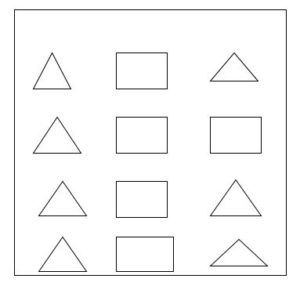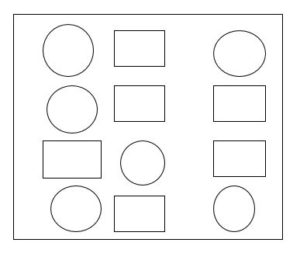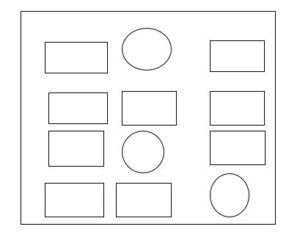Worksheet on Ratio in Simplest Form will assist students in learning the questions on how to write a given ratio in the simplest or lowest form. The Ratio in Simplest Form Worksheet available for Students features logical and reasoning aspects of maths in our day-to-day lives.
Practice at your own pace taking the help of the Expressing Ratios in Lowest Form Worksheet with Answers and gradually move on to difficult level problems on the topic too. Rely on the visual simulations in the interactive Worksheets for Ratios in Simplest Form and promote a better understanding of the topic.
See More:
- Worksheet on Ratio Problems
- Worksheet on Basic Problems on Ratio
- Worksheet on Word Problems on Proportion
Ratios in Simplest Form Questions and Answers
Example 1.
Express each of the following ratios in the simplest form
(i) 10 : 50
(ii) 2/7: 3/7
(iii) 6 : 18
(iv) 5 : 1 1/2
(v) 24 : 36
(vi) 22 : 55
(vii) 42 : 56
(viii) 250 : 300
Solution:
(i) 10:50
When we divide by 10 we get,
10/10:50/10
1:5
Hence, the simplest form of 10:50 is 1:5.
(ii) 2/7:3/7
When we divide by 7 we get,
2/7:3/7
2:3
Hence, the simplest form of 2/7:3/7 is 2:3.
(iii) 6:18
When we divide by 6 we get,
6/6:18/6
1:3
Hence, the simplest form of 6:18 is 1:3.
(iv) 6: 1 1/2
Converting the second part 1 1/2 as an improper fraction, we get
= 6 : 3/2
Multiplying both parts by 2, we get
= 6 ⋅ 2 : (3/2) ⋅ 2
= 12 : 3
Dividing by 3, we get
= 4 : 1
So, the simplest form is 4: 1.
(v) 24:36
When we divide by 6 we get,
24/6:36/6
4:6
When we divide by 2 we get,
=2:3
Hence, the simplest form of 24:36 is 2:3.
(vi) 22:55
When we divide by 11 we get,
22/11:55/11
2:5
Hence, the simplest form of 22:55 is 2:5.
(vii) 42:56
When we divide by 7 we get,
42/7:56/7
6:8
When we divide by 2 we get,
3:4
Example 2.
Convert each of the following ratios in the same units and then express in its lowest term
(i) 2 kg : 600 gm
(ii) 5 cm : 3 m
(iii) 2 m : 60 cm
(iv) 1 year : 8 months
(v) 2 hour : 40 minutes
(vi) 3 minutes : 50 seconds
(vii) 50 kg : 1 quintal
(viii) 50 paise : 1 Rupee
(ix) 75 cm : 3 m
(x) 300 m : 6 km
(xi) 4 hours : 1 day
Solution:
(i) 2 kg : 600 gm
we know that 1 kg=1000 gm.
2000 gm: 600 gm
20:6
By dividing with 2 we get
20/2:6/2
10:3
The simplest form is 10:3.
(ii) 5cm:3m
We know that 1m=100 cm.
5cm:300 cm
1:60
(iii) 2 m : 60 cm
we know that 1m=100 cm.
200 cm:60 cm
20 cm:6 cm
Divide with 2, we get
20/2 cm:6/2 cm
10 :3
(iv) 3 minutes : 50 seconds
we know that 1 minute=60 seconds.
180 seconds: 50 seconds
18:5
(v) 2 hour : 40 minutes
we know that 1 hour=60 minutes.
120 minutes:40 minutes
By dividing with 4 we get,
3:1
(vi) 3 minutes : 50 seconds
we know that 1 minute=60 seconds.
180 seconds:50 seconds
18:5
(vii) 50 kg: 1 quintal
we know that 1 quintal=1000 kg
50 kg:1000 kg
divide with 50 we get,
1:20
(viii) 50 paise : 1 Rupee
we know that 1 rupee=100 paise.
50 paise:100 paise
Divide with 50, we get
1 paise:2 paise
(ix) 75 cm : 3 m
we know that 1m=100 cm.
75 cm: 300 cm
By dividing with 75 we get,
1:4
(X) 300 m: 6 km
we know that 1 km=1000 m.
300 m: 6000 m
3:60
By dividing with 3 we get,
3/3:60/3
1:20
(xi) 4 hours : 1 day
we know that 1 day=24 hours.
4 hours: 24 hours
By dividing with 4, we get
1:6
Example 3.
Express as a ratio in simplest form
a) Find the ratio of the number of triangles to squares

b) Find the ratio of the number of circles to squares

c) Find the ratio of the number of rectangles to circles

Solution:
a) In the given diagram,
No. of triangles=7
No. of squares=5
The ratio of no. of triangles to squares is=7/5
Hence, the ratio of triangles to squares is 7/5.
b) In the given diagram,
No. of circles=6
No. of squares=6
The ratio of no. of circles to squares is=6/6=1:1.
Hence, the ratio of no. of circles to squares is 1:1.
c) In the given figure,
No. of rectangles=9
No. of circles=3
The ratio of no. of rectangles to squares is=9/3=3:1.
Hence, the ratio of no. of rectangles to squares is 3:1.
Example 4.
Express each of the following ratios in form 1: n
a) 2: 5
b) 3: 8
c) 6: 12
d) 12: 7
e) 9: 19
f) 6: 49
Solution:
a) 2:5
By dividing with 2, we get
2/2:5/2
1:2.5
b) 3: 8
By dividing with 3, we get
3/3:8/3
1: 2.6
c) 6:12
By dividing with 6, we get
6/6:12/6
1:2
d) 12: 7
By dividing with 12, we get
12/12:7/12
1:0.5
e) 9:19
By dividing with 9, we get
9/9:19/9
1:2.1
f)6:49
By dividing with 6, we get
6/6:49/6
1:8.1
Example 5.
Express each of the following ratios in the form n: 1
a) 9: 4
b) 7: 5
c) 14: 6
d) 3: 7
e) 5: 10
(f) 18: 9
Solution:
a) 9:4
By dividing with 4, we get
9/4:4/4
2.2:1
b) 7:5
By dividing with 5, we get
7/5:5/5
1.4:1
c) 14: 6
By dividing with 6, we get
14/6:6/6
2.3:1
d) 3: 7
By dividing with 7, we get
3/7:7/7
0.4:1
e) 5: 10
By dividing with 10, we get
5/10:10/10
0.5:1
(f) 18: 9
By dividing with 9, we get
18/9:9/9
2:1
Example 6.
In a park there are 8 adults and 20 children. What is the ratio of adults to children?
Solution:
Given,
No. of adults=8
No. of childhren=20
The ratio of adults to childhren=8/2=2/5
Therefore, the ratio of adults to children is 2/5.
Example 7.
Raju mixes 3 liters of milk with 1 liter of water. Find the ratio of water to milk?
Solution:
No. of liters of milk=3
No. of liters of water=1
The ratio of water to milk is=1/3
Hence, the ratio of water to milk is 1/3.
Example 8.
In a marriage hall, there are 250 men and 150 women. Find the ratio of men and women in the auditorium?
Solution:
No. of men in the auditorium=250
No. of women in the auditorium=150
The ratio of men and women in the auditorium is=250/150=5/3
Therefore, the ratio of men and women in the auditorium is 5:3.
